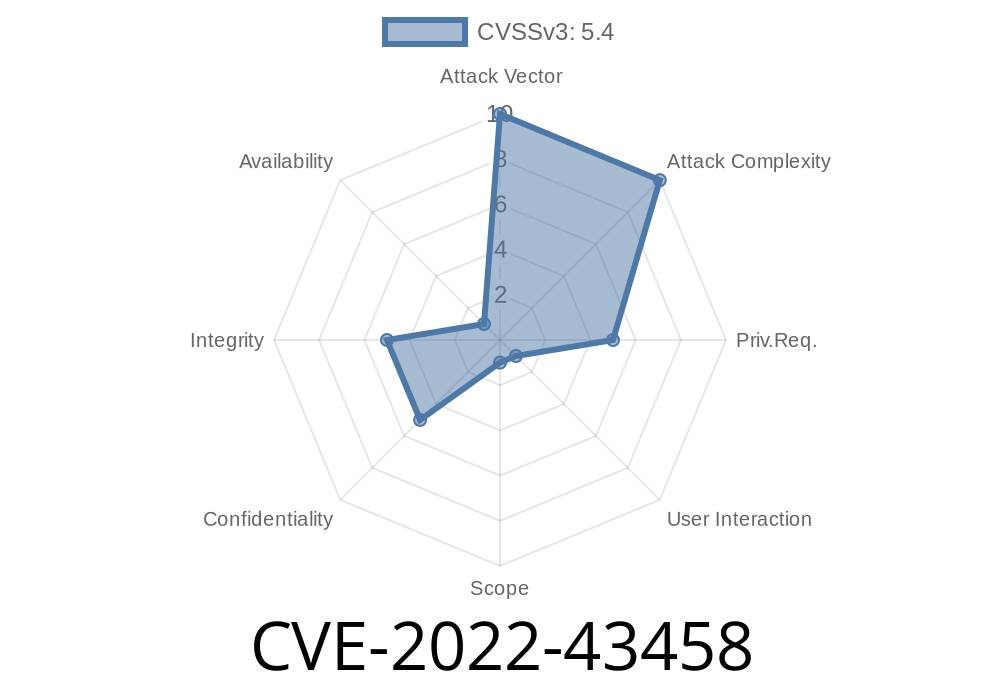A recent vulnerability, CVE-2022-43458, has been identified in the popular WordPress plugin, Advanced Floating Content by Code Tides. Versions up to and including 1.2.1 are affected by a Cross-Site Scripting (XSS) flaw. This post covers the details of the vulnerability, its potential impact, and steps to mitigate this issue for your WordPress site.
Background on Cross-Site Scripting (XSS)
Cross-Site Scripting is a type of vulnerability in which an attacker can potentially insert malicious scripts into a vulnerable website or application. When these scripts are executed, they can gain access to sensitive information, deface websites, or redirect users to other malicious sites. For a more detailed understanding of XSS, the following resources can be helpful:
- OWASP's comprehensive guide on XSS: https://owasp.org/www-community/attacks/xss/
- A beginner's guide to understanding and preventing XSS: https://www.acunetix.com/blog/articles/preventing-xss-attacks/
Description of CVE-2022-43458
The Advanced Floating Content plugin contains an authenticated stored XSS vulnerability that allows any contributing user or higher to insert malicious JavaScript code into a WordPress site using the plugin.
Here's a code snippet explaining the vulnerable parameter
~~~~
...
...
~~~~
As you can see from the snippet above, the afcpopup_setting_popup_font_color parameter is not properly sanitized or verified, making it susceptible to being exploited with malicious payload injections.
Exploitation Example
An attacking user with contributor level access or higher could create or edit a post and insert the following payload into the post content:
~~~~
alert('XSS')
~~~~
Upon saving the post, the payload will be executed by the server and stored within the afcpopup_setting_popup_font_color parameter value. Any user with admin or author access who views the post will then trigger the payload execution, causing a popup box with the message 'XSS' to appear. This is a basic example, but an attacker can potentially use similar techniques to insert more sophisticated or harmful payloads.
Remediation Steps
As of now, the plugin's developers have not released an update to address the issue. However, there are a few steps you can take to mitigate the issue on your end:
1. Remove the plugin - If the plugin is not critical to the functionality of your site, you can opt to remove it and look for an alternative that offers similar functionality but without the vulnerability.
2. Restrict user roles - Limit the number of users with "contributor" level access or higher on your WordPress site. This will shorten the attack surface, reducing the likelihood of an attacker exploiting the vulnerability.
3. Update your WordPress site and plugins - Regularly updating your WordPress site and installed plugins can help you stay protected from publicly disclosed vulnerabilities.
To keep up-to-date with the status of CVE-2022-43458 and to check for any available patches or updates, the following resources can be valuable:
- The official WordPress plugin repository: https://wordpress.org/plugins/tags/advanced-floating-content/
- The CVE database: https://cve.mitre.org/cgi-bin/cvename.cgi?name=CVE-2022-43458
In summary, CVE-2022-43458 is an authenticated Cross-Site Scripting vulnerability in the Advanced Floating Content plugin by Code Tides. WordPress site owners using versions up to and including 1.2.1 are advised to take steps to mitigate the vulnerability and follow best practices for plugin security.
Timeline
Published on: 04/16/2023 09:15:00 UTC
Last modified on: 04/21/2023 04:16:00 UTC
